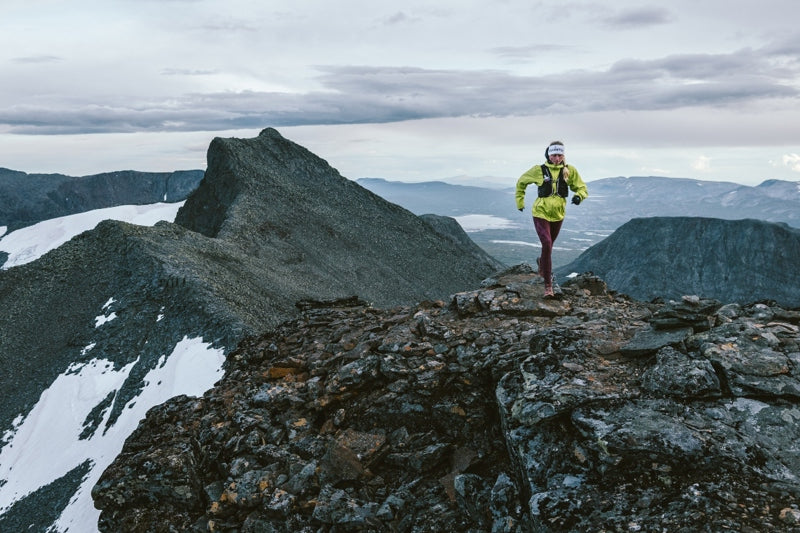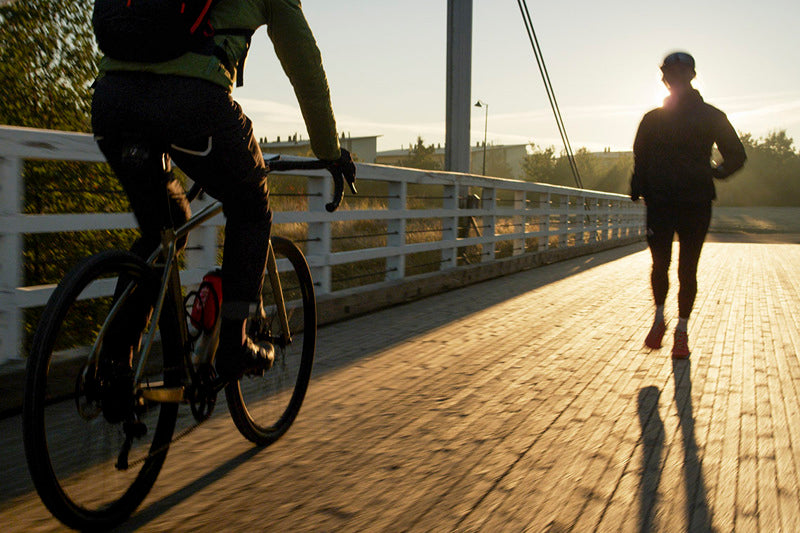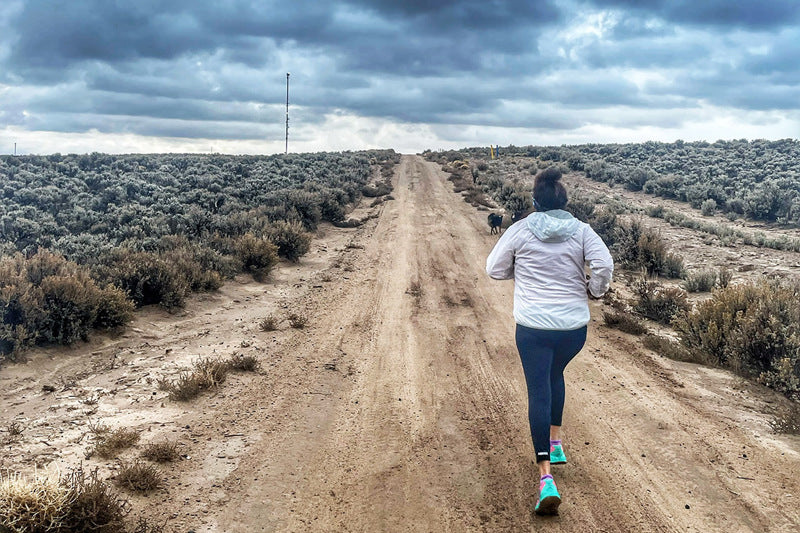

Suunto Blog

Turn it all off and come back to the present moment
Living just below the Arctic Circle in 2021 during the coronavirus pandemic Freya Orban, from southern Sweden, was missing sunshine and isolated due to social distancing restrictions.
Unable to do the things she loved — train with her cross-country skiing team, go trail running or to the gym to train — she became depressed. All the signs of stress and strain were showing, and then her dog died.
“That was the trigger for everything,” the 25 year Suunto athlete says. “Then I got shingles and couldn't get out of bed for a month.”
Piling on the pressure
At the worst low of her life, Freya started to question everything she was doing. Reflecting in this way allowed her to see what is important in her life, and what is superfluous. Like with so many competitive athletes, she used to pile too much pressure on herself. Going to races, managing her social media accounts, pleasing sponsors, pursuing academic excellence — she had become so busy and future-focused she had lost touch with the freedom and joy of running and being outdoors had always given her since she was a child. She had lost her presence. The simplicity of being in the here and now, senses open, taking in the beauty of the world.
Light at the end of the tunnel
Her journey into a dark place and into the light at the other end of the tunnel has led to massive change. She logged out of her social accounts, turned off her smartphone, stopped planning and instead focused on savoring simple presence in the outdoors and growing food in her garden. The sound of wolves howling in the distance (that’s Sweden!), the taste of wild blueberries, the feeling of wind on her face. Coming back to moment by moment experience, Freya healed herself and is now in the best place ever.
Leaving it all behind and running hut to hut
Watch the short film Presence below and follow Freya and her friend and photographer Lukas Dürnegger as they go on a fast packing hut to hut trip in the mountains of Jämtland in central Sweden. Over six days they ran 155 km with 5242 m of elevation gain. They left their smartphones at home and really tuned into the living world around them. Along the way they took time to stop a lot and ate handfuls of juicy blueberries and cloudberries.
Freya’s 3 tips to find presence
Rethink how you use social media
Freya’s approach to social media has changed. During some periods, she might sign in only once a month. And she posts only what she wants to look back on in a few years. It’s about keeping magical memories, not about sponsor-collaborations or gaining followers. Freya says being busy with screens and social media can make our senses dull and tuned out.
Pay attention to the little things
“A lot of people are caught in hamster wheels,” Freya says. “We go to work and tick off boxes on our to-do lists. But by the end of the day we can’t even remember what was happening. We rush through everything and miss things.”
To reverse this condition, Freya suggests going out into nature and opening up all the senses. “Try to use all your senses,” she says. “Not just your vision. Use your hearing, sense of smell, even taste, touch — the raindrops on your forehead. Everything you encounter out there, really try to feel it.”
Leave the tech at home
Once a week, leave all your technology at home and go out into nature for a run or a hike. Leave your earbuds, smartphone, GPS sports watch at home and be in the here and now. “Make it about being in nature and running for the joy of it,” Freya says.
All images by Lukas Dürnegger

Bikepacking the Arctic Post Road
The Arctic Post Road goes through one of Europe’s largest wilderness areas.
You don’t have to ask Suunto ambassador and bikepacking maniac Sami Sauri twice if she’d like to go on an adventure. And sure enough, when fellow Suunto ambassador Henna Palosaari sent Sami an email asking if she’d like to join her on a summer bikepacking trip up above the Arctic Circle, the emojis she got as a reply said it all.
Adventure starts here.
The two had never ventured into this kind of territory before. At least not on bikes. The trail follows remnants of the old Kopenhagen-Alta post road. They had an incredible experience. Long days in the saddle without seeing another human being. Or anything for that matter. Just trees, hills and lakes. Apparently the most wild mushrooms in 60 years. Oh, and reindeer of course. Hundreds of them. Same with mosquitos. They also experienced the kindness of the locals.
“Experiencing the simplicity of life up north and the local culture combined with the tranquility of the long wilderness sections creates a bikepacking experience that takes you miles away from the city hustle,” Henna says.
Press play to watch their short film and see for yourself.
The route
By the numbers:
430 km distance
7215 m total ascent
749 m is the highest point
81 % is unpaved
45 % single track
Duration: six to eight days
All images by Mikko-Pekka Karlin

Great effort by Suunto community to slash CO2e together
To motivate people to ride and run to work and to slash their CO₂ emissions (CO2e), we invited our community to join the first ever Suunto Commuting Day on September 22. The response was great: the community tracked nearly 380.000 km of human-powered commutes with their Suunto watches and Hammerhead bike computers. That’s just about the same distance as going from Earth to the moon!
Impressive first time results
The most popular commuting activity types were cycling, running and walking. Half of the commutes were cycling, a third was running and the rest walking – with some skateboarding, roller skiing and even swimming thrown in the mix.
The most common commuting distance for cyclists was 8,4 km, for runners 6,1 km and walkers 2,9 km. When looked closer at the cycling distances the distribution is quite equal:
Less than 5km commuting distance 26%
5–10 km commuting distance 32%
10–20 km commuting distance 25%
More than 20 km commuting distance 17%
Time-wise, runners had the longest duration commutes. The most common commuting durations were:
Running 39 min
Walking 37min
Cycling 29min
When looking at different nations, the Swedes were the most active bike commuters as the ratio between their bike commutes and bike rides in general was the highest. Other countries on the active commuter list were Germany, France, Finland and the UK.
Choosing human-powered travel
Human-powered commutes are good for both you and the planet as transportation is one of the biggest sources of emissions worldwide. When comparing the distance the community traveled with driving that same distance in a combustion-powered car, the estimated CO2e savings were over 65.000 kg. That’s the equivalent of 260 one hour passenger flights.
France, Japan, Finland, Spain and Germany accounted for the top 5 largest CO2e savings in total.
“We are stoked that we got so much participation even though it was the first Suunto Commuting Day and we had very little lead in time,” says Suunto’s Sustainability manager Heidi Heikkinen. “This shows how much interest there is — we expect the CO2e savings to increase next time.
“One single bike ride to work may not seem like a big commitment, but once you do that on a regular basis, you will start to see how it all adds up. And, when looking at the entire community, it is clear that thousands of people choosing human-powered commutes regularly can definitely make a difference.”
Track your commutes
In its increased focus on sustainability, Suunto has given its community the ability to track human-powered commutes and – as an extra motivation – see the estimated CO2e savings compared to driving that same distance.
To get started, track your commutes with a Suunto watch or a Hammerhead bike computer and tag the activity as a commute in Suunto app. In Suunto app you will see how much CO2e you have saved. You don’t even need to have a Suunto watch or a Suunto compatible Hammerhead bike computer to track your human-powered commutes: you can also use Suunto app and track with it for free. You can download Suunto app for iOS here and for Android here.
Committed to be a force for good
Promoting sustainable everyday choices is part of Suunto’s commitment to being a more responsible company. Today, more than 90 % of Suunto products are made in its factory in Vantaa, Finland. Since 2021, its HQ and factory have used 100% renewable energy. And to keep things transparent, it has recently published its first annual sustainability report that you can read here.“Suunto’s approach to sustainability is to increase positive effects, not just to reduce the negative ones. These are called, respectively, our handprint and footprint. We aim to tread lightly, and be a force for good. We believe in the power of community. Together, we can affect change by raising our voices and taking real action. Our ambassadors and our community care as much as we do,” says Brand manager Antti Laiho.
Read more
Learn more about tracking human-powered commutes and your CO2e savingsLearn more about Suunto’s approach to sustainabilityLearn more about Suunto’s comprehensive offering to cyclists

Join Suunto Commuting Day and fight CO2e emissions together
We are stoked to announce our inaugural Suunto Commuting Day to be held on Thursday, September 22. It’s simple to join: track your commute with a Suunto watch or a Hammerhead bike computer and tag the activity as a commute in Suunto app. After the event, we’ll show how much CO2e emissions our community has saved.
“One single bike ride to work may not seem like a big commitment,” says Suunto’s Sustainability manager Heidi Heikkinen. “But once you do that on a regular basis, you will start to see how it all adds up. And, when looking at the entire community, it is clear that thousands of people choosing human-powered commutes can definitely make a difference. Especially knowing that transportation is one of the biggest sources of emissions.”
You don’t even need to have a Suunto watch or a Suunto compatible Hammerhead bike computer to start tracking your human-powered commutes: you can also use Suunto app and track with it for free. You can download Suunto app for iOS here and for Android here.
“Suunto’s approach to sustainability is to increase positive effects, not just to reduce the negative ones. These are called, respectively, our handprint and footprint. We aim to tread lightly, and be a force for good. We believe in the power of community. Together, we can affect change by raising our voices and taking real action. Our ambassadors and our community care as much as we do,” says Brand manager Antti Laiho.
Learn more about tracking human-powered commutes and your CO2e savings
Learn more about Suunto’s approach to sustainability

Who’s having the most fun exercising? Here’s the answer – based on data!
Feeling is an excellent metric for recovery. If your feelings after exercise start to trend downwards, something is not right. You may be pushing too hard, not recovering well enough or might be getting sick. Consider taking a break or doing something different for a change.
But in addition to helping you track your recovery, feeling data reveals more. Here are six interesting findings about Suunto community, based on the data from Suunto app database.
1. Activity type does matter: The best feelings on average are recorded after dancing, downhill skiing, horseback riding, badminton and snowboarding.
2. Two activity types stand out as exceptionally poor: The feelings after running and trail running are clearly below other activity types.
3. Weather does not have a big impact on the feeling – unless it is a torrential downpour: The activity type, for example choosing cycling over running, has a much bigger impact.
4. Gender makes a difference: Women have more (or at least as much) fun as men in all other activity types except soccer.
5. Age does not matter: The age of the athlete did not have a correlation with the mood after exercise.
6. Country heavily impacts the mood: People exercising in Austria, China, Croatia, Poland and Serbia are generally feeling exceptionally well after a training session, while France, Italy, Japan, Spain and Sweden are in the opposite end of the list with much poorer feelings after working out.
In addition to fun facts, the data also reveals interesting trends: As an example, the feeling in cycling, swimming and walking rose to a new, higher level in March 2020 and has stayed on that higher level. Changes in other activity types since Covid pandemic started have not been as clear.
Happy adventures – and keep on tracking your activity feelings for your own wellbeing and our shared interest!
Lead image: Harald Wisthaler Bikewash image: Anthony Bonello

A native runner's perspective on inclusivity
Verna Volker became a runner to lose weight, but instead fell in love with it and found it brought her closer to herself. She grew up in the Dzilnaoodilii area of New Mexico and is from Navajo Nation. A former second grade teacher, she lives in Minneapolis, Minnesota with her husband and four children.
“My journey has taken me from a newbie runner to a marathoner and recently to an ultra-marathoner when I finished my first Ultra 50-mile race,” Verna says. “My desire is to use my running to inspire others.”
In this article, Verna explains her experience as a native runner in the United States and what we can all do to make the running scene more welcoming and inclusive for indigneous runners.
By Verna Volker
Diversity isn’t new to me. When I started my running journey, I became aware of the lack of diversity in the running community. It wasn’t just at the races, it was also evident on magazine covers and in running apparel advertising. I remember scanning through social media, and only seeing one type of runner: thin, blonde, white and fast. I didn’t see myself so I decided to create a space for our native women to be seen running. On January 23, 2018, before there was a drive for diversity in the mainstream running scene, I created Native Women Running, an Instagram account for this purpose for native women runners across the United States and Canada.
In the wake of the death of George Floyd, and other widely reported cases of injustice here in the US, running companies, individuals and organizations reached out to me asking for native runners to participate on their panels, teams or anything to show they were taking diversity seriously in their spaces. A majority of these were white-led spaces who wanted to make change and be good allies. Many focused on having diversity, but not necessarily having inclusivity. “Inclusion” is defined as “embracing all people irrespective of race, gender, disability, medical or other need.” It’s about giving equal access and opportunities to people of color while eliminating discrimination and intolerance. Another way I saw this defined is, “diversity is being invited to the ball, inclusion is being asked to dance.”
As a native runner, I wanted to put a spotlight on native runners. The running world, like so much of society, has failed to remember this land that so many of us enjoy running on is native land. For the native community it is considered stolen land. Native runners have a different perspective from non-native runners while out running. Yes, we run competitively, however our running focuses on healing, ceremony, and prayer.
It’s been four years since I've been involved in the native running community. Time and time again, running organizations, companies, and everyone and everything running related ask me for ideas to help them become better allies to our native community.
Though I don’t speak for all natives, here are a few of my best ideas for organizations looking to be more inclusive of native runners.
Offer a land acknowledgment
This is usually a formal statement that is written or a verbal recognition of the ancestral lands of native peoples. It’s recognizing the past, present and future of our native people. When delivering a land acknowledgment, it’s important to do careful research, educate the audience and think about your end goals of such a statement. Here is a great resource on appropriate ways for going about this: https://nativegov.org/news/a-guide-to-indigenous-land-acknowledgment
Going beyond land acknowledgment
Though It's important to give a land acknowledgement with true self-reflection and good intentions, it’s equally important to consider the action that underpins the acknowledgement. Often land acknowledgement is performative, vague, trendy or something to check off the to-do-list. To go beyond a land acknowledgement means to support local native running communities in the area of your events. That can range from compensating native runners for any emotional labor, to supporting native youth programs by donating funds or forming partnerships that will benefit native communities.
Build real authentic relationships with native runners
For example, two years ago, I reached out to Go-Guarded, a self-defense product for active individuals. I wanted to provide their products to the followers of Native Women Running. Shortly after my email, the company responded and provided a discount code for our followers. Since then, they have continued to support Native Women Running and my own personal journey. They have donated to and participated in our events. They didn’t just show up once, but continue to do so to this day.
Platform native runners
Give native runners opportunities to be on your board, panel, advisory team or serve as ambassadors. More importantly, listen to them, take them seriously and learn from them.
Provide scholarships
There are many native runners who are capable of competing but just don’t have the means to do so. Sponsoring allows more opportunities and gives more visibility to a group that is often underrepresented.
Give exposure
Give native running organizations, companies or individuals opportunities to have exposure at running expos. Exposure of their work to the general running community will allow others to support, build partnerships and form relationships.
Offer a safe space for native runners
A safe space not only provides physical safety but also psychological and emotional safety. White spaces can be due to racial harassment, microaggression and dismissing the experience and concerns of native people. Ask yourself questions such as: will native runners feel that accommodations are as welcoming as they traditionally have been for white runners? Will native runners feel welcome and included in that space? Educating, listening, learning, and getting uncomfortable will give you a greater understanding on how to show up for native runners.
There are many ways to incorporate inclusivity into running, but it’s important to have a plan and have the will to act on the plan. This work is hard, but very much appreciated. As a native runner, I have personally experienced being in a white space where I was dismissed, misunderstood, used, gaslit, publicly shamed and unheard. It led to conflict that left me traumatized. Though it has been a season of healing and learning for me, I will continue to move forward with optimism and a hope and for the continued mission of Native Women Running.



































































